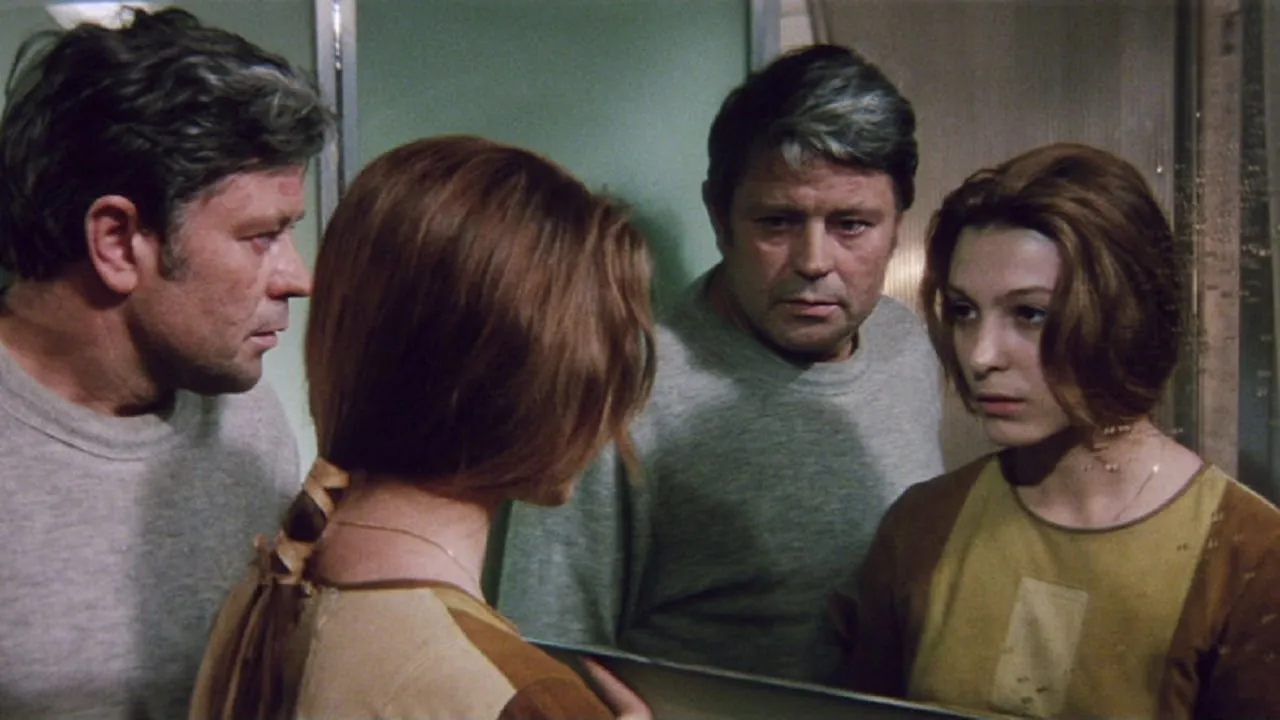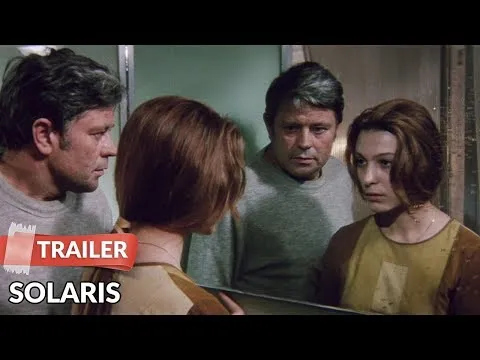
Cold War was that fascinating, sometimes dangerous, but generally stable period of world history when two greatest powers on Earth – United States and Soviet Union – took great pains to evade direct military confrontation with each other. They compensated lack of such hostilities with intense rivalry in every other form of human endeavour – espionage, propaganda, space exploration, sports and even such esoteric areas like science fiction cinema. The best known film to be produced as a result of such rivalry was Solaris, 1972 Soviet film directed by Andrei Tarkovsky.
The film is based on eponymous 1961 novel by Polish author Stanislaw Lem, which became immensely popular in East Bloc countries and the rest of the world and is now considered to be one of the classics of the genre. The novel has been previously adapted in 1968 as eponymous Soviet television play. The new version is set in relatively near future and begins on Earth where psychologist Kris Kelvin (played by Donatas Banionis, voiced by Vladimir Zamansky) visits summer house of his old father (played by Nikolai Grinko) shortly before he is to fly to space and travel to research station orbiting planet Solaris. His father’s friend Heri Berton (played by Vladislav Dvorzhetsky) is former astronaut who has visited the surface of the ocean planet and experienced strange phenomena his superiors interpreted as hallucinations. Kelvin initially has the same opinion, but he would change his mind after he arrives at the station, which now has only three members of the crew. He finds station in very poor state and the crew isn’t better – he learns that one of them, his friend Dr. Gibarian (played by Sos Sargsyan) has committed suicide and left cryptic video message. Two surviving members – Dr. Snaut (played by Jüri Järvet, voiced by Vladimir Tatosov) and Dr. Sartorius (played by Anatoly Solonitsyn) – don’t seem to offer much explanation but warn Kelvin to expect some unpleasant and possibly frightening phenomena. Kelvin soon encounters Hari (played by Natalya Bondarchuk), his wife who committed suicide few years earlier. Frightened and at odds how to explain such resurrection, he tricks Hari into escape pod and launches her into space. But Hari then appears again. Sartorius and Snaut explain that they too deal with “visitors” – creatures apparently created by sentient planet that apparently read scientists’ minds and decided to model them on peoples’ past or subconscious. Kelvin now must have to deal with Hari with whom he is again in love despite both him and her being aware that she is an artificial creation.
Solaris is considered the most popular of all Tarkovsky’s films and that could be best explained with its science fiction credentials that expanded its fandom from the art film crowd that loves works of Russian director. It premiered at 1972 Cannes Film Festival where it won Special Jury Prize and later was advertised internationally as “Soviet answer to American 2001: A Space Odyssey”. Tarkovsky himself later claimed that he wanted to make film different from Kubrick’s 1968 classic, which had considered “heartless” and too focused on technology at the expense of proper human emotions. In any case, two films have many things in common – both are directed by renowned cinema masters, both are based on works of popular science fiction authors, both take place at space station, both deal with the theme of First Contact, both feature interesting production design and use classic music as its soundtrack (here works of J. S. Bach, accompanied by atmospheric electronic music by Eduard Artemyev). But, there are also major differences. Most notable is Stanislaw Lem, unlike his counterpart Arthur C. Clarke who liked 2001, being famously indispleased with adaptation of his novel and accusing Tarkovsky of completely ignoring “science” aspect of science fiction for the sake of melodrama.
Taken on its own, without enthusiastic genre fandom or comparisons with its classics, Solaris gives ample reasons why Tarkovsky is an acquired taste for many cinephiles. On one hand, Tarkovsky’s visual talent is undeniable and many viewers would, at least initially, great appreciate great skill in which he portrays seemingly banal scenes that takes on Earth. On the other hand, to say that Solaris has problem with pace is big understatement. It takes almost an hour before the actual plot switches from Earth to the space station and even there it needs some time for things to get going. This results in almost three hours of running time that would require a lot of patience even from more experienced cinephiles. Script, co-written by Tarkovsky and Friedrich Gorenstein, on the other hand, does relatively good work in exposition and defining characters, while the ending works, despite being open to various interpretations.
Cast is mostly good, although Tarkovsky famously had problems with some of them. That included Lithuanian actor Donatas Banionis whose character is strangely passive and has problems in connecting with audience. His performance is overshadowed by work of supporting players, like Estonian actor Jüri Järvet and Anatoly Solonitsyn (who would later work with Tarkovsky on his next science fiction classic Stalker). But the best work belongs to Natalya Bondarchuk, young actress and daughter of famous Soviet film maker Sergei Bondarchuk, who plays Hari with great passion and provides her characters with different variations – as ghostlike presence, naive childlike creature, woman in love and, finally, someone willing to make ultimate sacrifice. She also provides element of very mild eroticism and, among other things, makes Solaris look more appealing and more bearable for general audience than dour, depressive and almost male-centric Stalker.
Great irony of Solaris is that Tarkovsky’s film, if seen through the prism of Cold War and comparison with 2001, could have given clear indication who would ultimately win that decades-long struggle. While Kubrick’s film was clear product of 1960s optimism and technological progress that would ultimately allow Americans to end the decade with triumphant landing on the Moon, Soviet film was, either by design or accident, product of the historic period known as Breznhevian Stagnation. While the nationality of characters and space station is deliberately vague, they might have easily be at home in early 1970s Soviet Union, a country which was rapidly losing technological race with the West, with dilapidated and messy space facility in Tarkovsky’s facility looking very much like rundown, obsolete, neglected and inefficient Soviet factories and the depressed unhappy characters very much like those having to live in decaying socialist system. Soviet technological inferiority can be seen even in way Solaris was filmed. Apparently unable to find proper locations or finances to show at least some glimpse of futuristic world within Soviet Union, Tarkovsky had to instead use long shots of early 1970s Akasaka, section of Japan that could, at least for average Soviet film goer, pass as something from technologically advanced future. On the other hand, Tarkovsky could have the last laugh if he lived long enough to see Hollywood’s 2002 attempt to remake his work under Steven Soderbergh’s direction, an effort that, despite all expectations, proved that technology and financial resources by themselves can’t make one film better than another.
RATING: 7/10 (+++)
_
Blog in Croatian https://draxblog.com
Blog in English https://draxreview.wordpress.com/
InLeo blog @drax.leo
InLeo: https://inleo.io/signup?referral=drax.leo
Stars Arena: https://www.starsarena.com/?ref=draxblog
Unstoppable Domains: https://unstoppabledomains.com/?ref=3fc23fc42c1b417
Hiveonboard: https://hiveonboard.com?ref=drax y
Bitcoin Lightning HIVE donations: https://v4v.app/v1/lnurlp/qrcode/drax
Rising Star game: https://www.risingstargame.com?referrer=drax
1Inch: https://1inch.exchange/#/r/0x83823d8CCB74F828148258BB4457642124b1328e
BTC donations: 1EWxiMiP6iiG9rger3NuUSd6HByaxQWafG
ETH donations: 0xB305F144323b99e6f8b1d66f5D7DE78B498C32A7
Posted using CineTV
